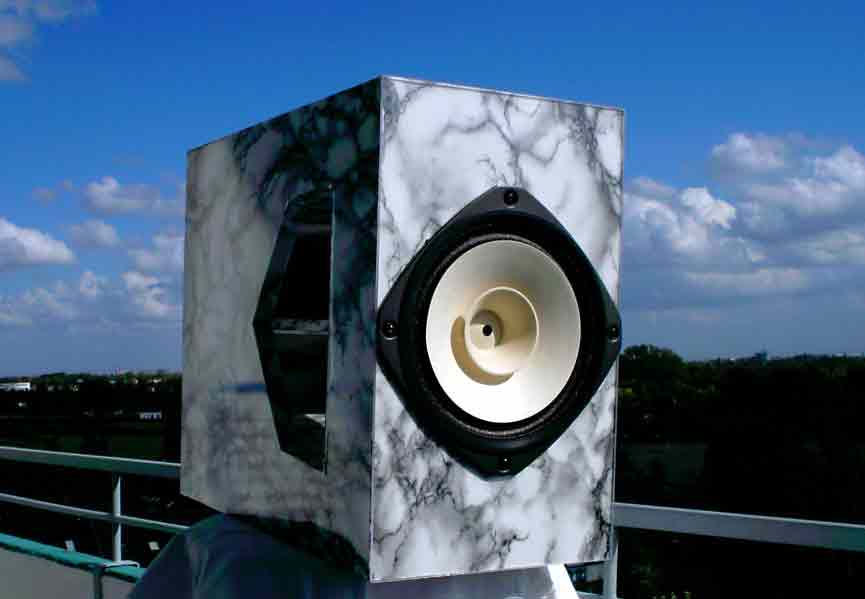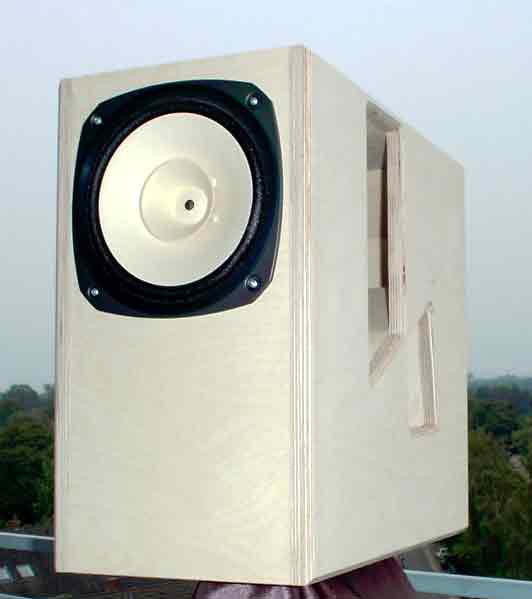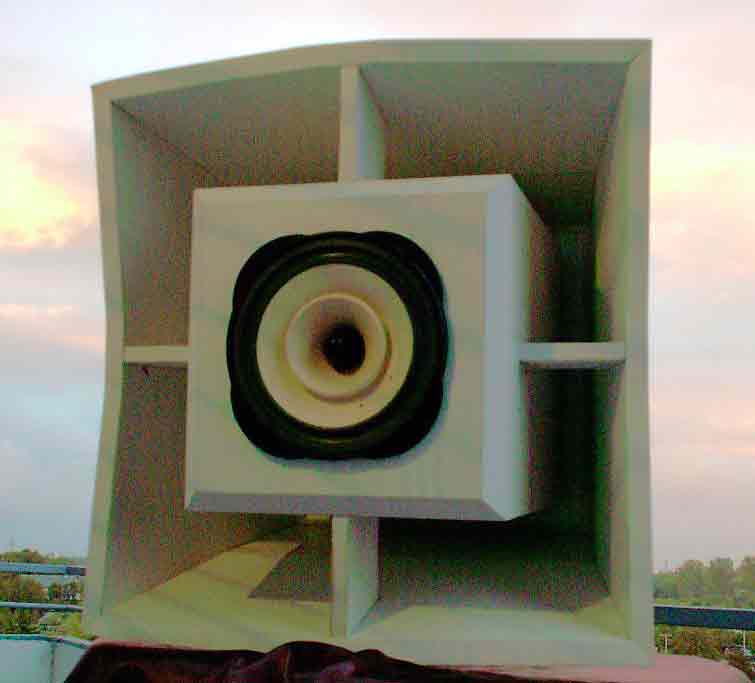I was wondering if most people do anything about the rising high freq response of full range drivers, or do you live with it finding the cure worse than the problem.
Specifically I want to make open baffle speakers hopefully with as small of baffles as possible with 18 inch H frames for support.
Thanks,
Paul
Specifically I want to make open baffle speakers hopefully with as small of baffles as possible with 18 inch H frames for support.
Thanks,
Paul
3 ideas............
1. sit way off axis.
2. use a 10 band equalizer.
3. buy drivers that don't rise (fe167e).
We are talking about drivers with a rising response, right ?
Similar to a fostex 206e ?
Because baffle step is a whole other topic.
Open baffles get around the baffle step problem.
But a small open baffle without massive eq using expensive drivers is a bad idea to me.
Martin J King has a neat design with dual 15 eminence and a full ranger (fostex or lowther).
here is a link to a bunch of pics.
notable is an alpair 10 OB over an h frame eminence 15" and a 103e over a 15".
http://www.quarter-wave.com/Gallery/Gallery.html
Damn that alpair 10, I want one.
Norman
1. sit way off axis.
2. use a 10 band equalizer.
3. buy drivers that don't rise (fe167e).
We are talking about drivers with a rising response, right ?
Similar to a fostex 206e ?
Because baffle step is a whole other topic.
Open baffles get around the baffle step problem.
But a small open baffle without massive eq using expensive drivers is a bad idea to me.
Martin J King has a neat design with dual 15 eminence and a full ranger (fostex or lowther).
here is a link to a bunch of pics.
notable is an alpair 10 OB over an h frame eminence 15" and a 103e over a 15".
http://www.quarter-wave.com/Gallery/Gallery.html
Damn that alpair 10, I want one.
Norman
Many (but not all) FR units exhibit some form of rising response for a variety of reasons. For e.g. the FE206E starts to lift at about 1.2KHz. There are a few things you can do about that, several of which are noted above.
1/ Most are intended to be listened to off-axis, so that's one. Eq of some form, passive or active, in terms of a shelving filter, is another.
2/A low-mid front horn is a useful option.
3/ A very large (back) horn will attenuate the extreme highs due to the considerable load being placed on the rear of the cone, which the diaphram & motor are not strong enough to overcome. But we're talking very big horns here. Otherwise, back horns are useful only from the chosen low-frequency cutoff Fo (whatever it might be) up to the driver's mass corner frequency Fhm, and can do nothing about any rising output from the driver above this point. You don't want to be running them up higher than about, oh, 300Hz, give or take, or you'll run into problems -output lobing, imaging instability and other the attendant issues.
1/ Most are intended to be listened to off-axis, so that's one. Eq of some form, passive or active, in terms of a shelving filter, is another.
2/A low-mid front horn is a useful option.
3/ A very large (back) horn will attenuate the extreme highs due to the considerable load being placed on the rear of the cone, which the diaphram & motor are not strong enough to overcome. But we're talking very big horns here. Otherwise, back horns are useful only from the chosen low-frequency cutoff Fo (whatever it might be) up to the driver's mass corner frequency Fhm, and can do nothing about any rising output from the driver above this point. You don't want to be running them up higher than about, oh, 300Hz, give or take, or you'll run into problems -output lobing, imaging instability and other the attendant issues.
Keep in mind that though the response rises on-axis, the larger fullrangers also get increasingly directional. So, if you listen a little of axis, you can achieve a relatively flat in-room balance with many of them. Rooms also tend to absorb a considerable amount of high frequency sound, depending on their furnishings, thus that on-axis rise may help balance things out.
You'll also find that folks prefer very different tonal balances. There are a bunch of traditional high end guys who like speakers with big ol' soft dome tweeters. In a highly furnished room, they'll often roll off pretty hard above 7-10K (check out Stereophile's published "in room response" graphs). Those guys tend to think of anything else as "bright".
On the other end of the spectrum, you'll find gents listening to FE206E's (10db on axis rise) in ill suited bass reflex enclosures (no bass) and praising their "detail" and "speed". It sure does sound interesting to have a giant FR rise, but I can't take it for very long.
You can assemble a fullrange driver system that has pretty much any frequency balance you want. I tend to like something that trends pretty flat. It depends on the driver, the enclosure, the room and placement.
Of course, you'll also find that many/most fullrangers have some peaks in their response that aren't simply part of a rising trend. Different folks also vary in their sensitivity to these. Some find drivers that are quite flat too smooth and boring Others are very sensitive to even small high Q (tall and narrow) peaks. But, I think this is a separate issue from your question about rising frequency response.
pj
www.wildburroaudio.com
You'll also find that folks prefer very different tonal balances. There are a bunch of traditional high end guys who like speakers with big ol' soft dome tweeters. In a highly furnished room, they'll often roll off pretty hard above 7-10K (check out Stereophile's published "in room response" graphs). Those guys tend to think of anything else as "bright".
On the other end of the spectrum, you'll find gents listening to FE206E's (10db on axis rise) in ill suited bass reflex enclosures (no bass) and praising their "detail" and "speed". It sure does sound interesting to have a giant FR rise, but I can't take it for very long.
You can assemble a fullrange driver system that has pretty much any frequency balance you want. I tend to like something that trends pretty flat. It depends on the driver, the enclosure, the room and placement.
Of course, you'll also find that many/most fullrangers have some peaks in their response that aren't simply part of a rising trend. Different folks also vary in their sensitivity to these. Some find drivers that are quite flat too smooth and boring Others are very sensitive to even small high Q (tall and narrow) peaks. But, I think this is a separate issue from your question about rising frequency response.
pj
www.wildburroaudio.com
pjanda1 said:... listening to FE206E's (10db on axis rise)
http://www.diyaudio.com/forums/showthread.php?postid=1824217#post1824217
dave
Disclosure: they were my phase plugs. And if you get a chance to go listen to his system, take your swimsuilt, he lives across the road from the beach
planet10 said:
http://www.diyaudio.com/forums/showthread.php?postid=1824217#post1824217
dave
Disclosure: they were my phase plugs. And if you get a chance to go listen to his system, take your swimsuilt, he lives across the road from the beach
I probably shouldn't have mentioned any specific products. I'm just trying to say that it is quite possible to achieve a relatively flat trending tonal balance with fullrange drivers. It is also possible to achieve a balance that leans one way or the other, and some folks seem to prefer it that way. Overall, I view rising HF response as more of a personal choice than a problem endemic to fullrangers, and if you find you don't like something, try something else without laying any judgement upon those who like the speaker you didn't.
Maybe others have opinions more topical for the original question?
pj
pjanda1 said:I probably shouldn't have mentioned any specific products.
Doesn't matter, it illustrated the point well enough.
I'm just trying to say that it is quite possible to achieve a relatively flat trending tonal balance with fullrange drivers. It is also possible to achieve a balance that leans one way or the other, and some folks seem to prefer it that way. Overall, I view rising HF response as more of a personal choice than a problem endemic to fullrangers, and if you find you don't like something, try something else without laying any judgement upon those who like the speaker you didn't.
Indeed. It's certainly not a given that an FR unit will exhibit a rising response. Some do, some are flat, some are slowly rolled off in the HF etc., just like many multiway designs are. You want HF rise -a couple of years back a Rodgers design had a 24db lift starting above 12KHz, IIRC. Personally, that makes me wince; I don't like bright speakers (just my taste) but I can understand the appeal, especially for middle-aged men with poor HF hearing. Everyone has their own requirements.
Imho most fullrange drivers (6,5" and larger) need some kind of treatment, on open baffle it is no difference, even though you can plan wisely to counter some peaks with your baffle layout.
Rising ones:
-sit way off axis and if you have some luck you even avoid (which is not likely) the 3-7KHz harshness most of them have
"Flat" ones by spec sheet(even Fe167e):
-in 99% they need a notch or two
Everything else is imho based on imagination(which is ok, be thankful for that) or sheer luck with your design and selection of driver.
Go for filters, it wont hurt.
-Micha
Rising ones:
-sit way off axis and if you have some luck you even avoid (which is not likely) the 3-7KHz harshness most of them have
"Flat" ones by spec sheet(even Fe167e):
-in 99% they need a notch or two
Everything else is imho based on imagination(which is ok, be thankful for that) or sheer luck with your design and selection of driver.
Go for filters, it wont hurt.
-Micha
pforeman said:I was wondering if most people do anything about the rising high freq response of full range drivers, or do you live with it finding the cure worse than the problem.
Specifically I want to make open baffle speakers hopefully with as small of baffles as possible with 18 inch H frames for support.
I have used Lowther drivers in boxes and on OBs. Lowther drivers are well known for having a rising response which can lead to a harsh, shrill, very fatiguing listening experience if they are used in any old box design. I have looked at three options and built and listened to two of them with my PM2A drivers.
1) An ML TL style of enclosure can work if you use a correction filter. The correction filter is required and improves the sound of the system making it extremely good sounding. There are no negative impacts of a properly sized filter other then a loss in efficiency. A correction circuit does not remove anything from the signal it just rebalances the SPL magnitudes and even corrects phase shifts associated with baffle step. In this type of system bass was limited to about 40 Hz, the design will not produce high volume subwoofer bass output.
2) An OB using two 15" woofers with my preference being high Qts woofers. All that is required is an active crossover set near 200 Hz, the full range driver produces everything above this point. I used my PM2A drivers without any compensation to offset a rising response. There was nothing between the amp and the PM2A driver. This was probably the best speaker I have had in my system producing a huge soundstage, amazing detail, good imaging, and tremendous dynamics. The downside was the size of the OB, I have now learned enough to believe that a much smaller baffle would have worked just as well (maybe a little of the bass would be sacrificed) and will rebuild the system at some point.
3) A hybrid TL/BLH that is corner loaded. I have a simulation design that yields a flat frequency response down to about 50 Hz for this style of enclosure. Because it is corner loaded the design has only one mouth and is not so large. Basically taking advantage of the corner the enclosure produces enough bass output to math the efficiency of the Lowther driver. This is on my list to finish and build. Unfortunately my list is long and my time is limited.
If you are looking to build an OB system with an active crossover to a large woofer or a pair of woofers I do not believe you need to be too concerned about the rising response of the full range driver.
- Status
- This old topic is closed. If you want to reopen this topic, contact a moderator using the "Report Post" button.
- Home
- Loudspeakers
- Full Range
- taming the rising high freq response of FR drivers


